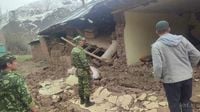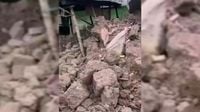On April 13, 2025, Tajikistan was rocked by a series of earthquakes that left a path of destruction across several regions of the country. The most powerful tremor registered a magnitude of 5.9, with its epicenter located in the Rasht region, approximately 171 kilometers southeast of Khudzhand, at a depth of 10 kilometers. This seismic activity resulted in significant damage, including the tragic death of a three-year-old child.
The European-Mediterranean Seismological Center (EMSC) confirmed that the initial tremor occurred at 09:24 local time, with subsequent aftershocks recorded at magnitudes of 4 and 3 occurring later in the day. The tremors were felt as far away as Southern Kazakhstan, indicating the widespread impact of the seismic events.
According to reports from the Geophysical Service of the National Academy of Sciences of Tajikistan, a total of 94 houses were completely destroyed, and numerous buildings, including schools and medical facilities, sustained damage. The crisis management center of the Committee on Emergency Situations and Civil Defense of Tajikistan reported that 17 residential buildings and a school in the Rasht region were partially destroyed.
In the aftermath of the earthquakes, President Emomali Rahmon ordered the establishment of a republican commission, led by Deputy Prime Minister Sulaimon Ziezoda. This commission is tasked with coordinating the response efforts, assessing the damage, and providing assistance to the affected communities. Rescuers were deployed to the region to help mitigate the consequences of the earthquakes, working tirelessly to assist those in need.
Footage of the destruction has emerged online, showing the extent of the damage. Over 200 support facilities, including schools, medical centers, and teahouses, were reported to have suffered damage. Videos shared on social media platforms depict the chaos and devastation experienced by local residents.
As the situation continues to unfold, local authorities are urging residents to remain vigilant and prepared for potential aftershocks. The earthquakes have raised concerns about the structural integrity of buildings in the region, prompting discussions about future safety measures and building standards.
The loss of life and property has left a profound impact on the communities affected by the earthquakes. Families are grappling with the aftermath, and many are in urgent need of shelter and support. The government's response will be critical in addressing these immediate needs and facilitating the recovery process.
In the coming days, the republican commission will focus on restoring essential services and ensuring that those displaced by the earthquakes receive adequate support. The government's ability to effectively coordinate relief efforts will be crucial in the wake of this natural disaster.
As the people of Tajikistan come together to face the challenges ahead, the resilience of the community will be tested. The solidarity shown by neighbors helping one another in times of crisis serves as a reminder of the strength found in unity.
In summary, the series of earthquakes that struck Tajikistan on April 13, 2025, have caused significant destruction and loss of life. With ongoing efforts to assess the damage and provide assistance, the nation is now focused on recovery and rebuilding in the aftermath of this devastating event.




